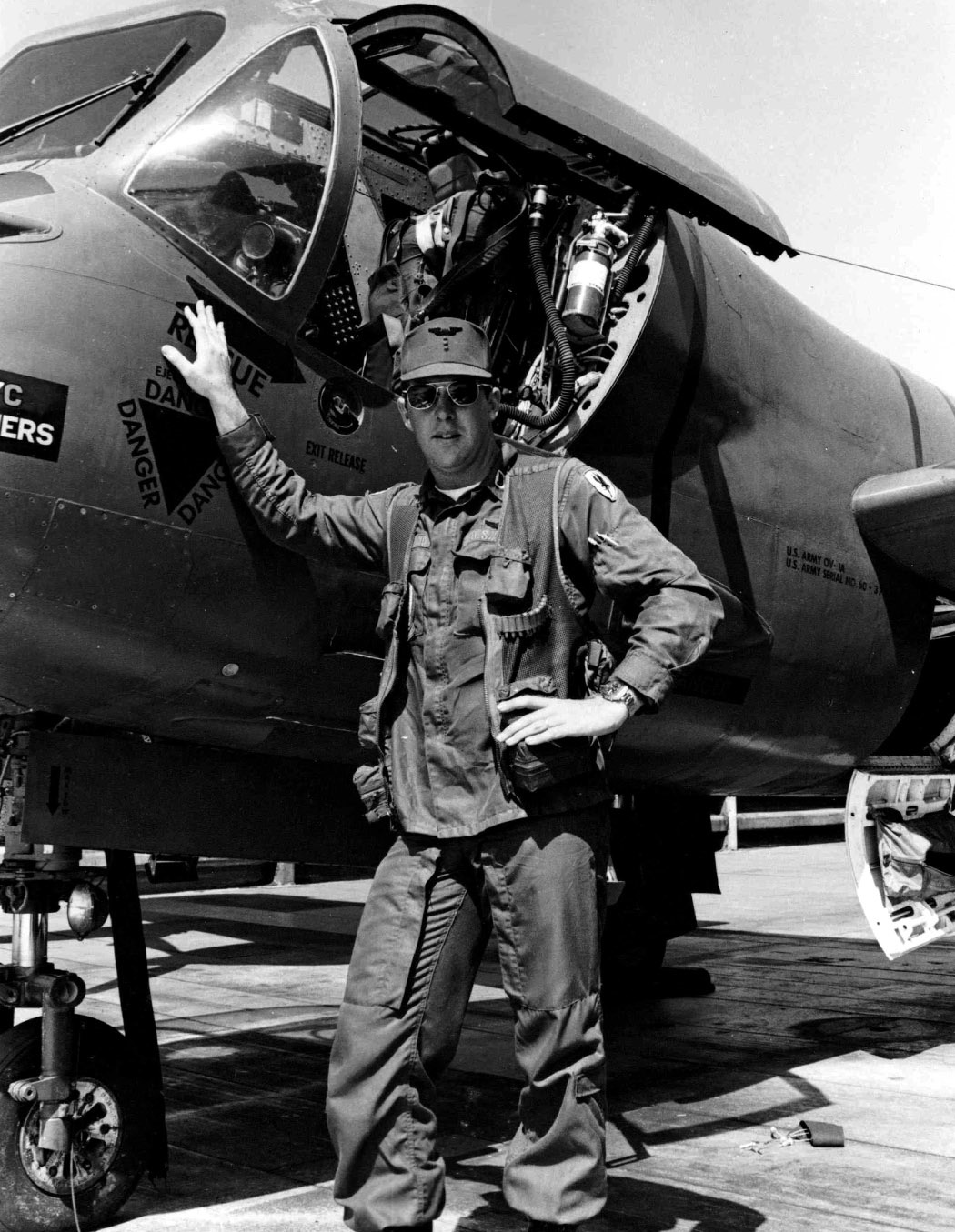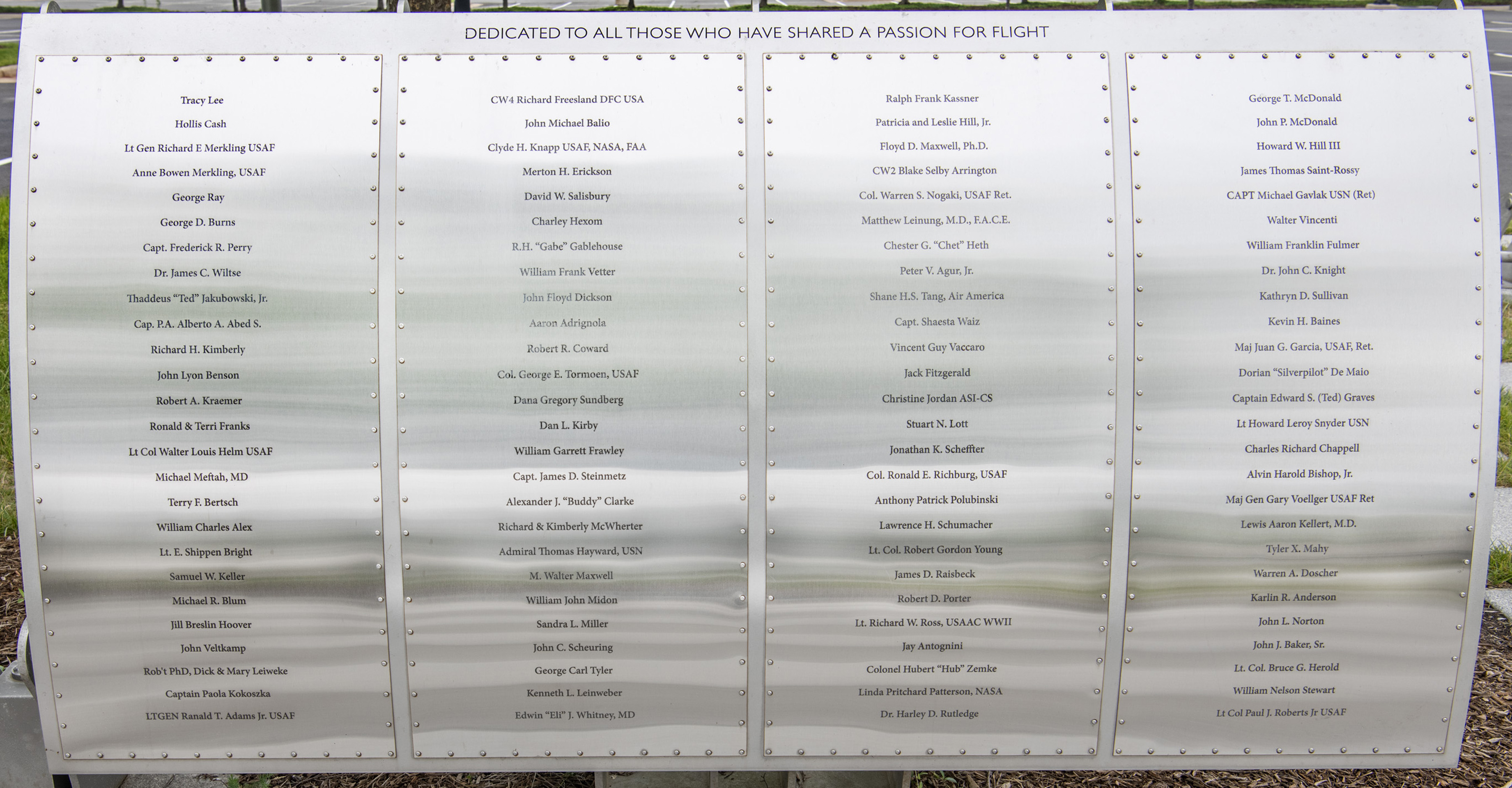
Foil: 41 Panel: 2 Column: 1 Line: 1
Wall of Honor Level: Air and Space Leader
Honored by:
His proud and grateful family
Honoree:
CW4 Richard P. Freesland DFC USA
Call Sign - SPUD 12
Honored by:
His proud and grateful family
Honoree Profile:
71 year old pilot with 50 years of US Army Aviation Service
Over 15,000 accident free hours
Enlisted in the US Army after hearing about its Warrant Officer Flight Training Program during an ROTC recruitment campaign while attending Atlantic Christian Collage. The year was 1965. Completed Basic and Advanced Helicopter training in the OH-23, OH-13 and UH-1 at Fort Walters, Texas and Fort Rucker, Alabama. Graduated a Warrant Officer (WO1) and received wings in January 1967. Saw action with the 162nd Assault Helicopter Company (Vultures) at Phouc Vinh, Vietnam. Flew combat assaults and resupply missions in UH-1D helicopters supporting the 1st, 9th Infantry Divisions and US Special Forces Teams.
Returned stateside in February 1968 to the 6th Special Forces Aviation Detachment at Fort Bragg, North Carolina flying UH-1B helicopters and U-10A airplanes in support of Special Operations and the Special Warfare School. Promoted to Chief Warrant Officer (CW2) and graduated from the Special Warfare School. Transitioned into the OV-1 Mohawk, a single pilot reconnaissance aircraft, and received orders back to Vietnam. February 1970, assigned to the 225th Surveillance Airplane Company (Phantom Hawks) at Phu Hiep Army Base. Spent the year as Assistant Operation Officer flying nights in the darkest place on earth, the Northwestern mountain region of Vietnam.
Back stateside to the 184th Military Intelligence Company at Fort Lewis, Washington. As the Flight Standardization Officer was tasked to train pilots on the new OV-1D for deployment to Korea and Germany. Recognizing the OV-1D's unique capabilities, was tasked by the Army Corps of Engineers for missions throughout North America.
1973, off to Fort Rucker for the Instrument Examiner Course and the newly developed Warrant Officer Advance Course and promotion to CW3. The Army decided that all helicopter pilots will get a full instrument ticket versus the tactical ticket they got in flight school. Selected as Instrument Flight Examiner and ordered back to Fort Lewis, teamed to set up a helicopter instrument course with the support of aircraft from the 118th Assault Helicopter Company (Hornets). For completing the assignment in record time, the Army awarded us with any overseas assignment. Chose Hawaii.
July 1977 promoted to CW4 and assigned to the 3rd Squadron 4th Cavalry (3/4 Cav), 25th Infantry Division at Wheeler Air Force Base, Oahu, Hawaii. For the next five years as the Headquarters Troop Flight Operations Officer and Standardization Officer, flew UH-1H and OH-58 helicopters, supporting missions throughout the Hawaiian Islands and Pacific Basin.
1982 back stateside with the 3rd Military Intelligence Battalion (Nighthawks) Fort Hood, Texas as the Assistant Flight Operations and Flight Standardization Officer, flying the OV-1D aircraft again. World wide deployments were the norm. Selected as one of the III Corps Aviation Flight Section pilots flying UH-1H, U-21 and C12 VIP aircraft around Central and North America. Retired (Active Duty) 31 December 1985 with 20 years of US Army Aviation Service.
January 1986 hired as a Department of the Army Civilian (DAC) GS-2181-13 pilot assigned to Northeast Flight Detachment, Headquarters, Army Depot Systems Command (DESCOM), US Army Material Command (AMC), Letterkenny Army Depot, Chambersburg, Pennsylvania. As Chief, Flight Operations Officer, flew UH-1H, C-12, U-21, T-42, and King Air 200+ aircraft, providing 24/7 support of depot operations in North America ensuring timely transport of critical items during Operation Enduring Freedom and Operation Iraqi Freedom (Gulf War).
July 1992 reassigned to the US Army Operational Support Airlift Command (OSACOM), Davison AAF, Fort Belvoir, Virginia. As Flight Operations Officer and Flight Standardization Officer flew C-12 VIP aircraft in support of Government Agencies throughout North America, Central America and the Caribbean. 1996 Reassigned to Aviation Office, Headquarters, US Army Material Command (AMC), Eisenhower Avenue, Alexandria Virginia as the Flight Standardization Officer flying C-12, UV-18 , UH-1. Responsible for pilot training, standardization and oversight of eleven AMC flight activities throughout the United States.
2007 reassigned to the Aviation Division, Air Systems Division, US Army Night Vision Labs, Davison AAF, Fort Belvoir, Virginia as Chief, Operations Officer and Developmental Test Pilot flew C-12J2, UV-18A and UH-1H aircraft. As a Developmental Test Pilot for eight years, tested and evaluated airborne sensor systems to aid pilots during degraded conditions. Flight tested and qualified most airborne sensors in use on Unmanned Aerial Vehicles (UAV's). Supported real time special government airborne operations. Retired (Civil Service) 31 December 2015 with a total of 50 years of US Army Aviation Service.
Ratings:
Airplane: Pilot-in-Command, Standardization Instructor Pilot, Instrument Flight Evaluator, Developmental Test Pilot
Helicopter: Pilot-in-Command, Instrument Flight Evaluator, Developmental Test Pilot
Awards: Distinguished Flying Cross, Bronze Star 3 Oak Leaf Clusters, Air Medal 47 Awards, Army Commendation 2 Oak Leaf Clusters, Meritorious Service Medal, Army Achievement Medal, Achievement Medal for Civilian Service 3 Oak Leaf
Personal letter from WO1 Richard P. Freesland to his Mom and Dad dated March 6th, 1967 describing the circumstances surrounding his winning the Distinguished Flying Cross while serving his first tour of duty in Vietnam.
March 6th, 1967
Dear Mom and Dad,
Well things have been happening. I have so much to tell you I don't know where to start. I don't know if this was on the news over in the U.S., but a chopper crashed just on the other side of the border in Cambodia on Friday March 3rd at 10:42. That was me and Captain DeGraw. It took place in the Junction City zone. I was in the first flight of five to go into this LZ to pick up some American troops that were being overrun by VC. We took on seven troops, our normal load, and started off with the rest of the flight. After reaching translational lift with about 40 knots of airspeed and 40 to 50 feet altitude, I noticed a drop in RPM. In order to build it back, the pitch was placed down. It built up a bit but in order to clear some tall trees we had to hold what we had and dropped the RPM into the caution zone. We nosed her over in order to gain enough airspeed to make a cyclic climb out. It was no use; we were too close to the trees weaving in and out avoiding the tall ones. Meanwhile the RPM alarm came on; a beeping tone something similar to a stall indicator in a fixed wing. Operating RPM is 6,600; it was just above 5,000 now and the blades were beginning to cone. We tried our best to find an area to put it down but we saw nothing but trees. We kept weaving in and out. With each turn we lost altitude. We came around one set of trees just to find two very tall ones right in our path. We made a last second effort to avoid them by diving her to the left. It was evident we were going in. Captain DeGraw warned, "Hold on, we are going in!" We leveled the ship and went into a wooded area of small trees about 40 feet high. We lost our tail rotor and skids in the trees. The main body of the aircraft rolled about 40 yards. It ended up on its right side. All I could think of was fire; we had over 400 pounds of fuel onboard. I cut the switches, unbuckled, broke the Plexiglas overhead window, and crawled out. The whole crew got out about the same time. The seven troops were lying all over where the aircraft rolled. Four of them were injured. We got everybody away from the aircraft in case it blew up. A few minutes later there were all kinds of aircraft in the area. The injured were flown out. While we were waiting to be picked up, we took everything of importance off the aircraft and prepared it to be blown up. We were picked up and flown to a secure area about 25 minutes after the crash. Upon arrival we were greeted by General Rogers and some other General who awarded Captain DeGraw, the aircraft commander and me, the pilot, the Distinguished Flying Cross. It was a hell of a way to win a medal.
We're still not sure what caused the drop off in the RPM but it most likely was a round shot into the compressor stage of the engine. As for the injuries the only member of the crew that got hurt was the left door gunner. He ended up with a compound broken wrist. There were a few broken legs and back injuries but no one was killed. All I got was a cut in my right leg where I slid out the window and a rope burn on one side of my shoulder where the harness held me in. We know the exact time of impact because both DeGraw's and the Crew Chief's watches stopped at 10:42. My old Rolex is still ticking on.
Needless to say we got Saturday off, but bright and early Sunday we were back in the saddle. We got 7 hours and 15 minutes more of the combat assaults. Captain DeGraw and I are still flying together. We made it through that, we can make it through anything.
It wasn't until last night that we learned we had crashed 300 meters inside Cambodia. An air-strike was called in to blow up what was left of the aircraft but the tail section, which broke off in the trees, was not destroyed. They got the tail number and it has blown into an international incident. All morning DeGraw, myself and the crew of the ship that followed us in have been talking to people from CIA, State Department and the accident board. So you can see there is never a dull moment. I've got more faith than ever in the old Huey. Now I know I can walk away from it after pushing it through the trees at 50 knots.
Love,
Rich
Wall of Honor profiles are provided by the honoree or the donor who added their name to the Wall of Honor. The Museum cannot validate all facts contained in the profiles.
Foil: 41
All foil images coming soon.View other foils on our Wall of Honor Flickr Gallery
